2006 DODGE RAM SRT-10 lock
[x] Cancel search: lockPage 1936 of 5267
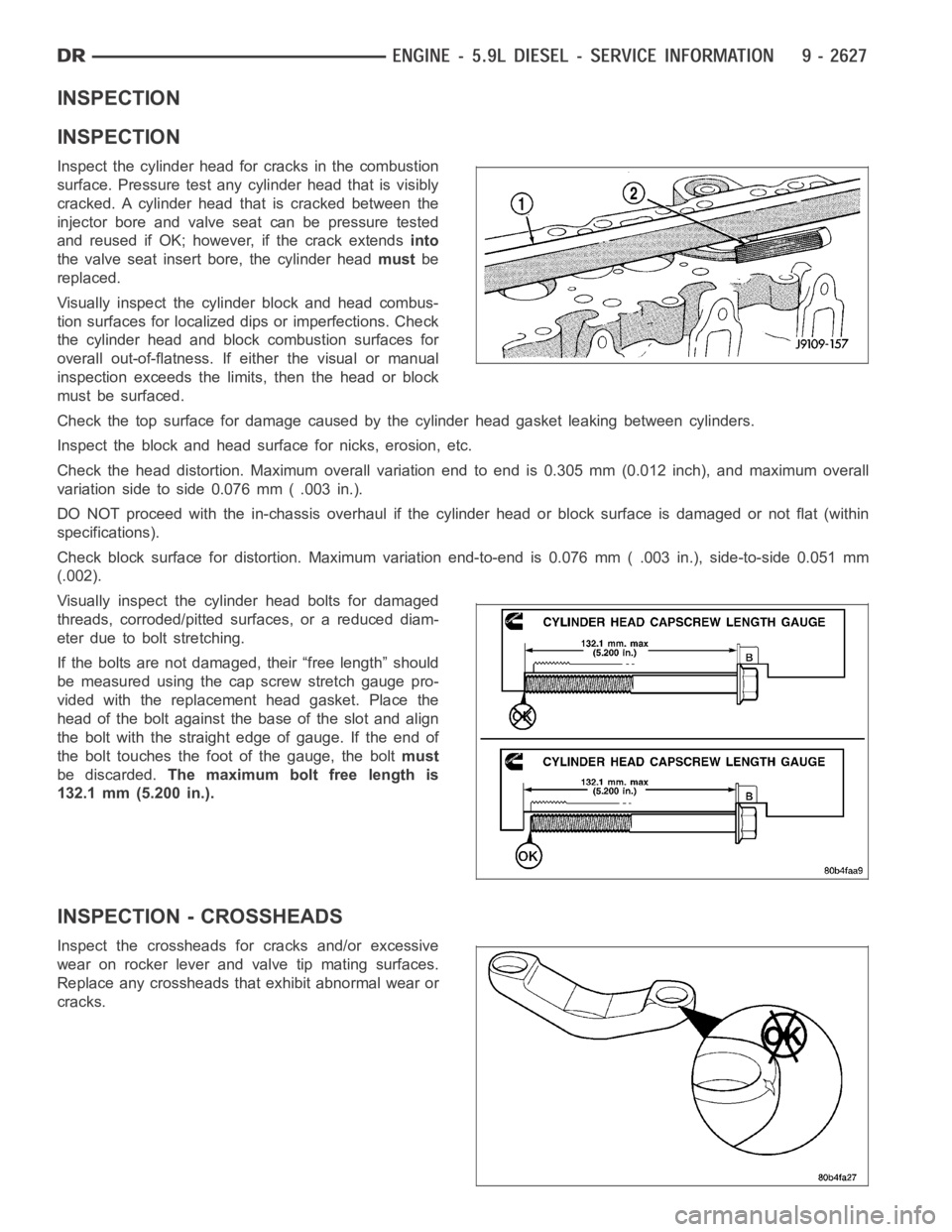
INSPECTION
INSPECTION
Inspect the cylinder head for cracks in the combustion
surface. Pressure test any cylinder head that is visibly
cracked. A cylinder head that is cracked between the
injector bore and valve seat can be pressure tested
and reused if OK; however, if the crack extendsinto
the valve seat insert bore, the cylinder headmustbe
replaced.
Visually inspect the cylinder block and head combus-
tion surfaces for localized dips or imperfections. Check
the cylinder head and block combustion surfaces for
overall out-of-flatness. If either the visual or manual
inspection exceeds the limits, then the head or block
must be surfaced.
Check the top surface for damage caused by the cylinder head gasket leakingbetween cylinders.
Inspect the block and head surface for nicks, erosion, etc.
Check the head distortion. Maximum overall variation end to end is 0.305 mm(0.012 inch), and maximum overall
variationsidetoside0.076mm(.003in.).
DO NOT proceed with the in-chassis overhaul if the cylinder head or block surface is damaged or not flat (within
specifications).
Check block surface for distortion. Maximum variation end-to-end is 0.076 mm ( .003 in.), side-to-side 0.051 mm
(.002).
Visually inspect the cylinder head bolts for damaged
threads, corroded/pitted surfaces, or a reduced diam-
eter due to bolt stretching.
If the bolts are not damaged, their “free length” should
be measured using the cap screw stretch gauge pro-
vided with the replacement head gasket. Place the
head of the bolt against the base of the slot and align
the bolt with the straight edge of gauge. If the end of
the bolt touches the foot of the gauge, the boltmust
be discarded.The maximum bolt free length is
132.1 mm (5.200 in.).
INSPECTION - CROSSHEADS
Inspect the crossheads for cracks and/or excessive
wear on rocker lever and valve tip mating surfaces.
Replace any crossheads that exhibit abnormal wear or
cracks.
Page 1948 of 5267
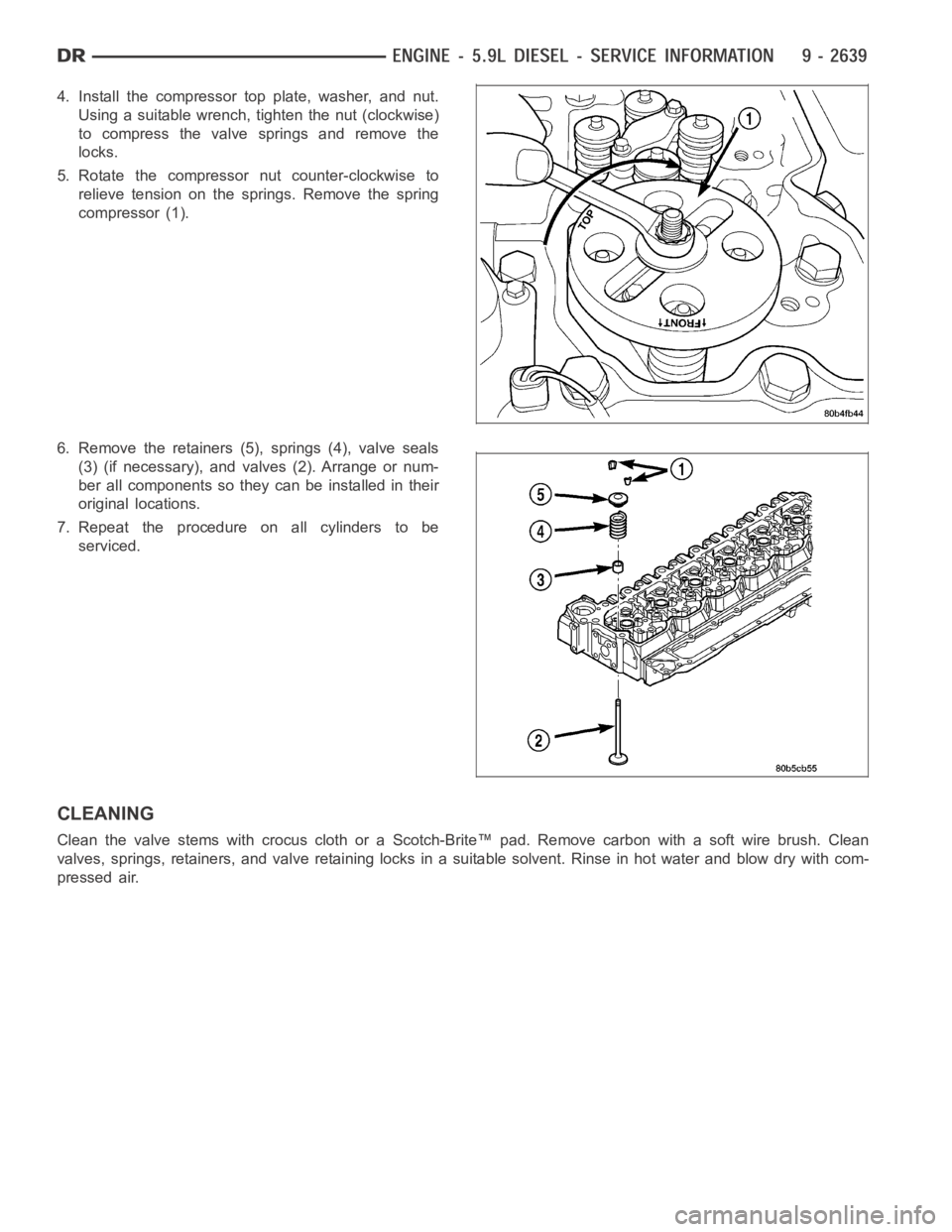
4. Install the compressor top plate, washer, and nut.
Using a suitable wrench, tighten the nut (clockwise)
to compress the valve springs and remove the
locks.
5. Rotate the compressor nut counter-clockwise to
relieve tension on the springs. Remove the spring
compressor (1).
6. Remove the retainers (5), springs (4), valve seals
(3) (if necessary), and valves (2). Arrange or num-
ber all components so they can be installed in their
original locations.
7. Repeat the procedure on all cylinders to be
serviced.
CLEANING
Clean the valve stems with crocus cloth or a Scotch-Brite™ pad. Remove carbonwithasoftwirebrush.Clean
valves, springs, retainers, and valve retaining locks in a suitable solvent. Rinse in hot water and blow dry with com-
pressed air.
Page 1952 of 5267
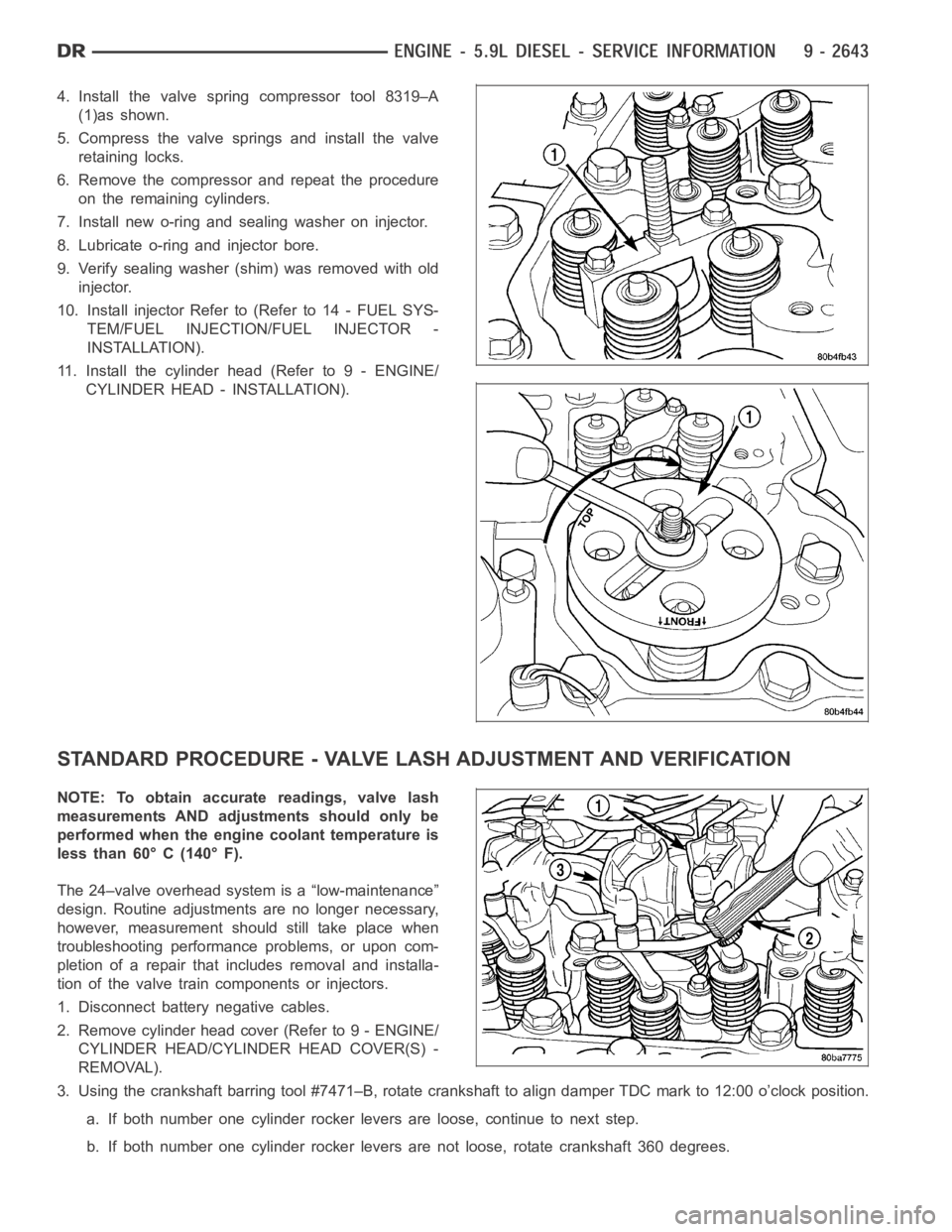
4. Install the valve spring compressor tool 8319–A
(1)as shown.
5. Compress the valve springs and install the valve
retaining locks.
6. Remove the compressor and repeat the procedure
on the remaining cylinders.
7. Install new o-ring and sealing washer on injector.
8. Lubricate o-ring and injector bore.
9. Verify sealing washer (shim) was removed with old
injector.
10. Install injector Refer to (Refer to 14 - FUEL SYS-
TEM/FUEL INJECTION/FUEL INJECTOR -
INSTALLATION).
11. Install the cylinder head (Refer to 9 - ENGINE/
CYLINDER HEAD - INSTALLATION).
STANDARD PROCEDURE - VALVE LASH ADJUSTMENT AND VERIFICATION
NOTE: To obtain accurate readings, valve lash
measurements AND adjustments should only be
performed when the engine coolant temperature is
less than 60° C (140° F).
The 24–valve overhead system is a “low-maintenance”
design. Routine adjustments are no longer necessary,
however, measurement should still take place when
troubleshooting performance problems, or upon com-
pletion of a repair that includes removal and installa-
tion of the valve train components or injectors.
1. Disconnect battery negative cables.
2. Remove cylinder head cover (Refer to 9 - ENGINE/
CYLINDER HEAD/CYLINDER HEAD COVER(S) -
REMOVAL).
3. Using the crankshaft barring tool #7471–B, rotate crankshaft to align damper TDC mark to 12:00 o’clock position.
a. If both number one cylinder rocker levers are loose, continue to next step.
b. If both number one cylinder rocker levers are not loose, rotate crankshaft 360 degrees.
Page 1953 of 5267
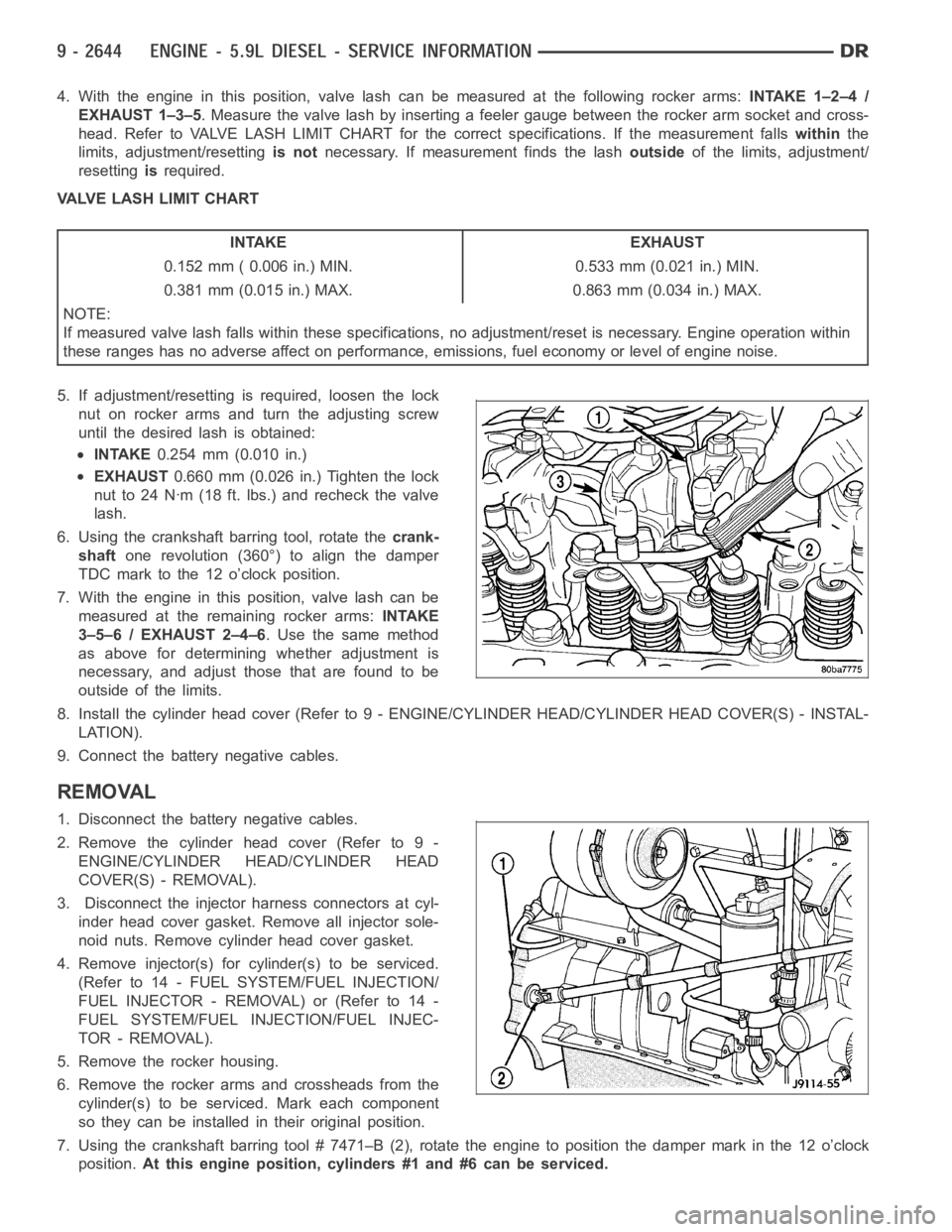
4. With the engine in this position, valve lash can be measured at the following rocker arms:INTAKE 1–2–4 /
EXHAUST 1–3–5. Measure the valve lash by inserting a feeler gauge between the rocker arm socket and cross-
head. Refer to VALVE LASH LIMIT CHART for the correct specifications. If the measurement fallswithinthe
limits, adjustment/resettingis notnecessary. If measurement finds the lashoutsideof the limits, adjustment/
resettingisrequired.
VALVE LASH LIMIT CHART
INTAKE EXHAUST
0.152 mm ( 0.006 in.) MIN. 0.533 mm (0.021 in.) MIN.
0.381 mm (0.015 in.) MAX. 0.863 mm (0.034 in.) MAX.
NOTE:
If measured valve lash falls within these specifications, no adjustment/reset is necessary. Engine operation within
these ranges has no adverse affect on performance, emissions, fuel economy or level of engine noise.
5. If adjustment/resetting is required, loosen the lock
nut on rocker arms and turn the adjusting screw
until the desired lash is obtained:
INTAKE0.254 mm (0.010 in.)
EXHAUST0.660 mm (0.026 in.) Tighten the lock
nut to 24 Nꞏm (18 ft. lbs.) and recheck the valve
lash.
6. Using the crankshaft barring tool, rotate thecrank-
shaftone revolution (360°) to align the damper
TDC mark to the 12 o’clock position.
7. With the engine in this position, valve lash can be
measured at the remaining rocker arms:INTAKE
3–5–6 / EXHAUST 2–4–6. Use the same method
as above for determining whether adjustment is
necessary, and adjust those that are found to be
outside of the limits.
8. Install the cylinder head cover (Refer to 9 - ENGINE/CYLINDER HEAD/CYLINDER HEAD COVER(S) - INSTAL-
LATION).
9. Connect the battery negative cables.
REMOVAL
1. Disconnect the battery negative cables.
2. Remove the cylinder head cover (Refer to 9 -
ENGINE/CYLINDER HEAD/CYLINDER HEAD
COVER(S) - REMOVAL).
3. Disconnect the injector harness connectors at cyl-
inder head cover gasket. Remove all injector sole-
noid nuts. Remove cylinder head cover gasket.
4. Remove injector(s) for cylinder(s) to be serviced.
(Refer to 14 - FUEL SYSTEM/FUEL INJECTION/
FUELINJECTOR-REMOVAL)or(Referto14-
FUEL SYSTEM/FUEL INJECTION/FUEL INJEC-
TOR - REMOVAL).
5. Remove the rocker housing.
6. Remove the rocker arms and crossheads from the
cylinder(s) to be serviced. Mark each component
so they can be installed in their original position.
7. Using the crankshaft barring tool # 7471–B (2), rotate the engine to position the damper mark in the 12 o’clock
position.At this engine position, cylinders #1 and #6 can be serviced.
Page 1954 of 5267
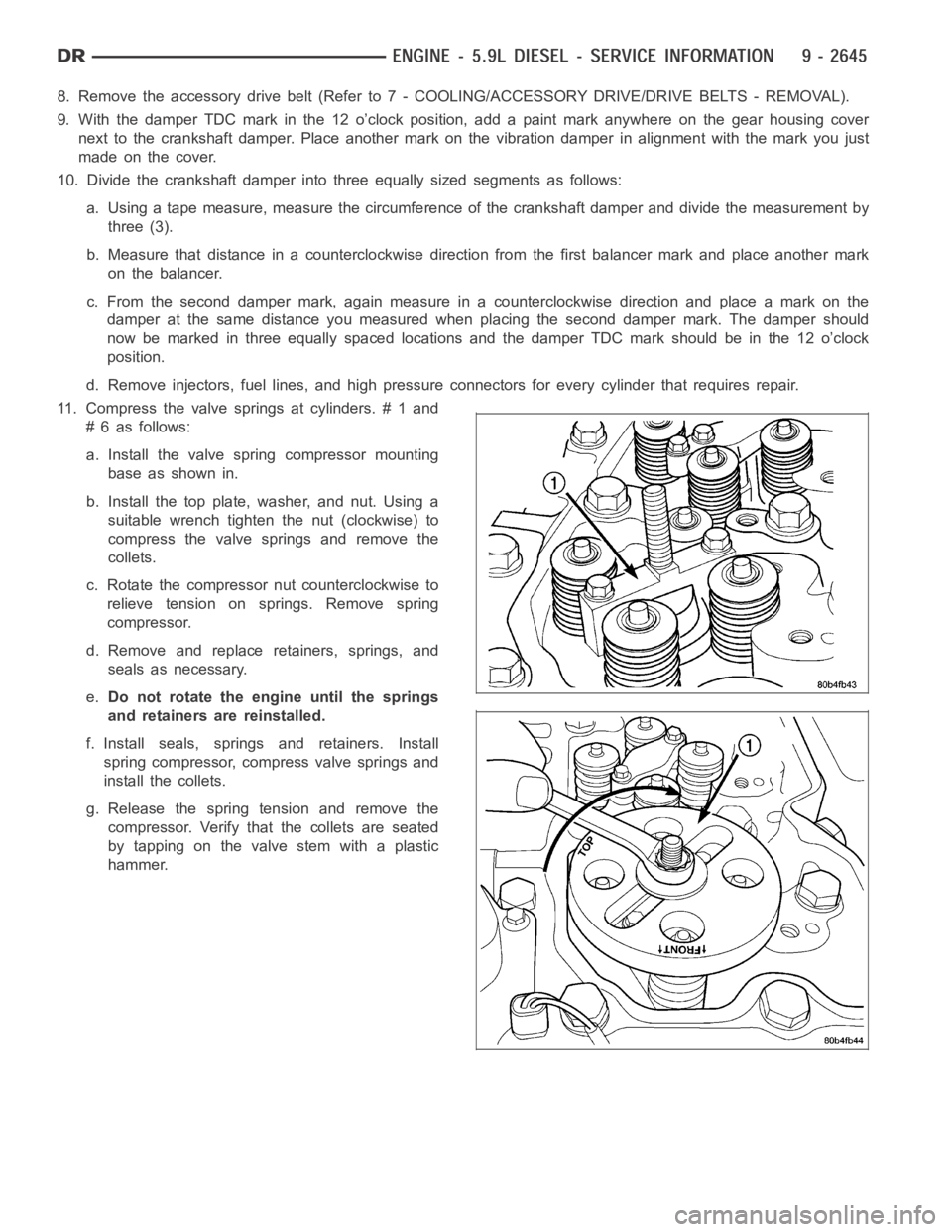
8. Remove the accessory drive belt (Refer to 7 - COOLING/ACCESSORY DRIVE/DRIVE BELTS - REMOVAL).
9. With the damper TDC mark in the 12 o’clock position, add a paint mark anywhere on the gear housing cover
next to the crankshaft damper. Place another mark on the vibration damper in alignment with the mark you just
made on the cover.
10. Divide the crankshaft damper into three equally sized segments as follows:
a. Using a tape measure, measure the circumference of the crankshaft damper and divide the measurement by
three (3).
b. Measure that distance in a counterclockwise direction from the first balancer mark and place another mark
on the balancer.
c. From the second damper mark, again measure in a counterclockwise direction and place a mark on the
damper at the same distance you measured when placing the second damper mark. The damper should
now be marked in three equally spaced locations and the damper TDC mark should be in the 12 o’clock
position.
d. Remove injectors, fuel lines, and high pressure connectors for every cylinder that requires repair.
11. Compress the valve springs at cylinders. # 1 and
# 6 as follows:
a. Install the valve spring compressor mounting
base as shown in.
b. Install the top plate, washer, and nut. Using a
suitable wrench tighten the nut (clockwise) to
compress the valve springs and remove the
collets.
c. Rotate the compressor nut counterclockwise to
relieve tension on springs. Remove spring
compressor.
d. Remove and replace retainers, springs, and
seals as necessary.
e.Do not rotate the engine until the springs
and retainers are reinstalled.
f. Install seals, springs and retainers. Install
spring compressor, compress valve springs and
install the collets.
g. Release the spring tension and remove the
compressor. Verify that the collets are seated
by tapping on the valve stem with a plastic
hammer.
Page 1956 of 5267
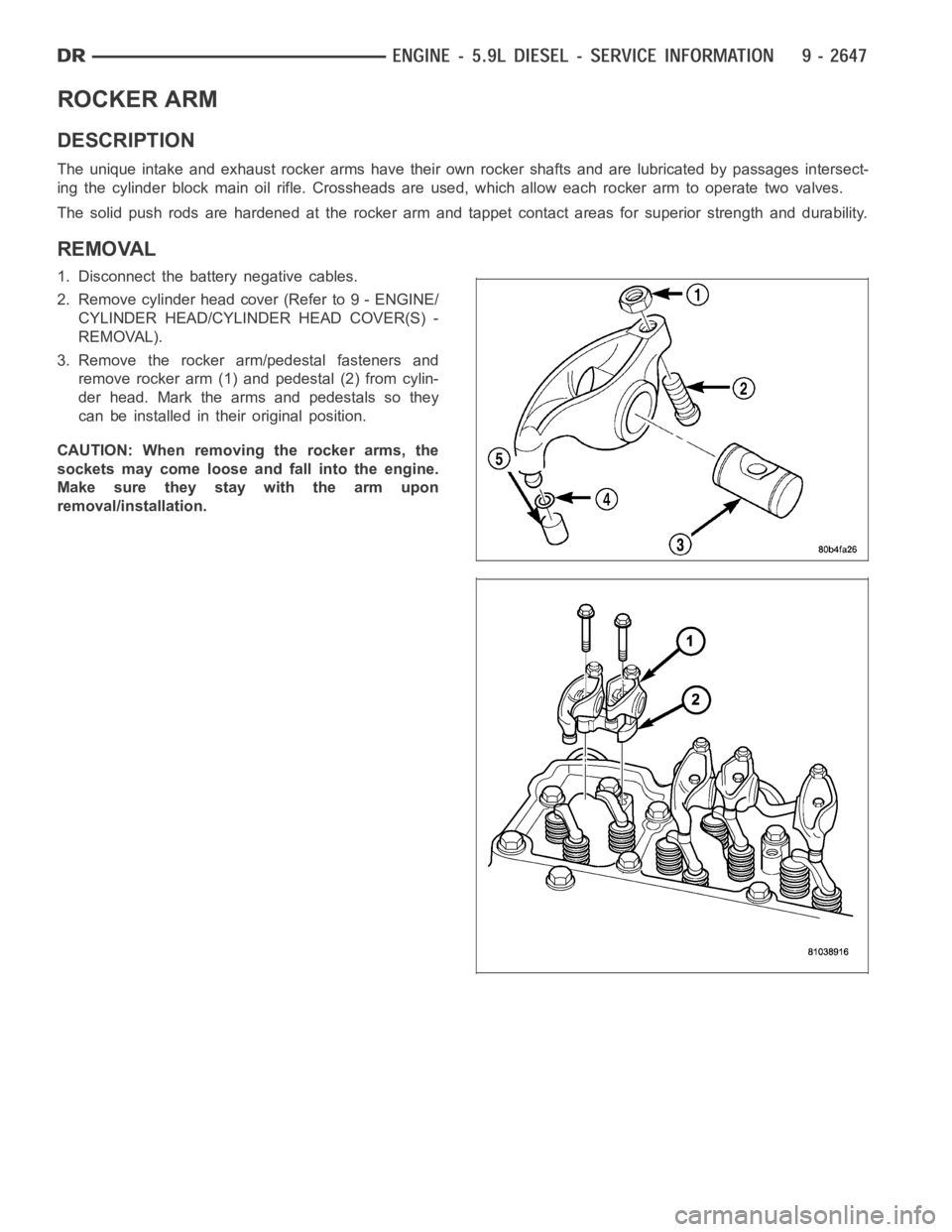
ROCKER ARM
DESCRIPTION
The unique intake and exhaust rocker arms have their own rocker shafts and are lubricated by passages intersect-
ing the cylinder block main oil rifle. Crossheads are used, which allow each rocker arm to operate two valves.
The solid push rods are hardened at the rocker arm and tappet contact areas for superior strength and durability.
REMOVAL
1. Disconnect the battery negative cables.
2. Remove cylinder head cover (Refer to 9 - ENGINE/
CYLINDER HEAD/CYLINDER HEAD COVER(S) -
REMOVAL).
3. Remove the rocker arm/pedestal fasteners and
remove rocker arm (1) and pedestal (2) from cylin-
der head. Mark the arms and pedestals so they
can be installed in their original position.
CAUTION: When removing the rocker arms, the
sockets may come loose and fall into the engine.
Make sure they stay with the arm upon
removal/installation.
Page 1960 of 5267
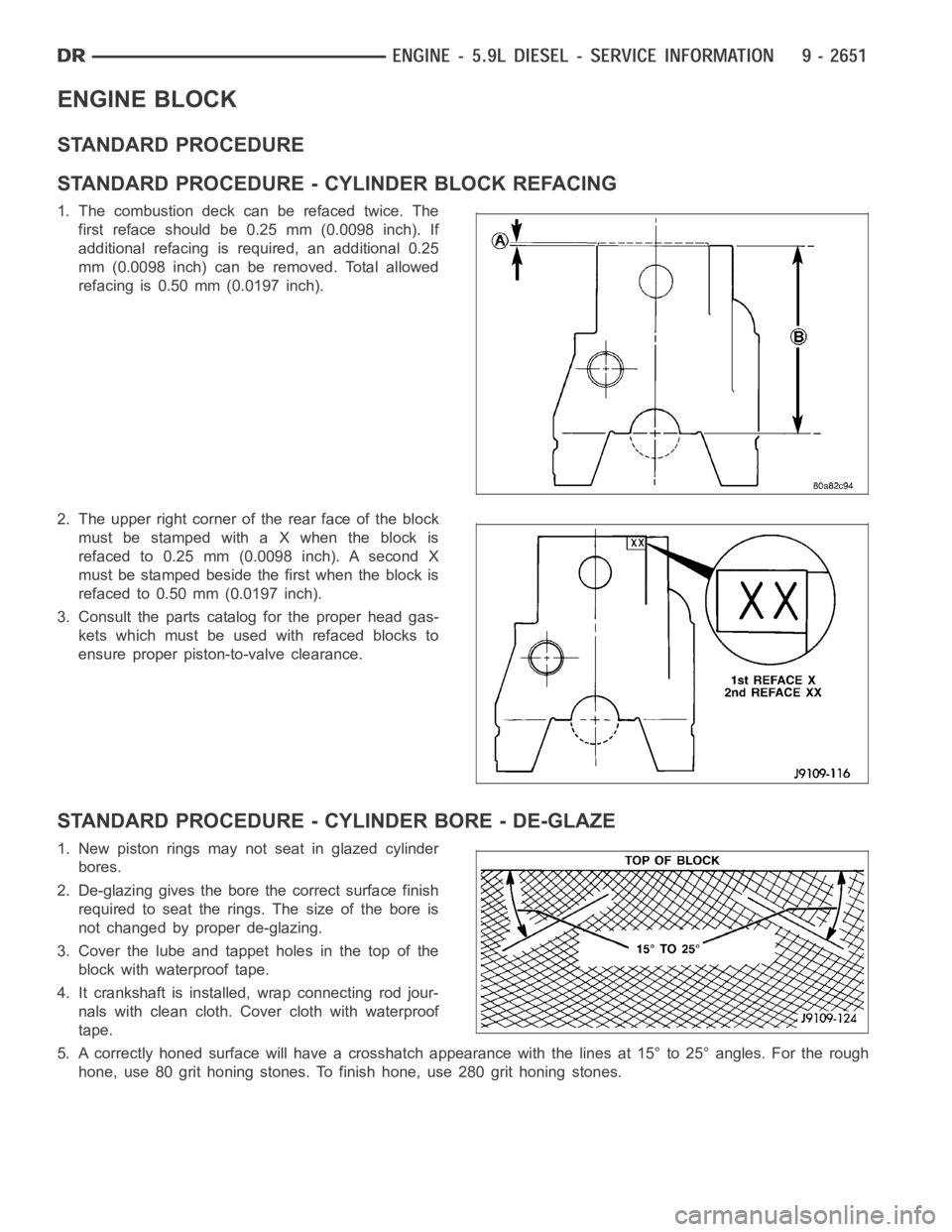
ENGINE BLOCK
STANDARD PROCEDURE
STANDARD PROCEDURE - CYLINDER BLOCK REFACING
1. The combustion deck can be refaced twice. The
first reface should be 0.25 mm (0.0098 inch). If
additional refacing is required, an additional 0.25
mm (0.0098 inch) can be removed. Total allowed
refacing is 0.50 mm (0.0197 inch).
2. The upper right corner of the rear face of the block
must be stamped with a X when the block is
refaced to 0.25 mm (0.0098 inch). A second X
must be stamped beside the first when the block is
refacedto0.50mm(0.0197inch).
3. Consult the parts catalog for the proper head gas-
kets which must be used with refaced blocks to
ensure proper piston-to-valve clearance.
STANDARD PROCEDURE - CYLINDER BORE - DE-GLAZE
1. New piston rings may not seat in glazed cylinder
bores.
2. De-glazing gives the bore the correct surface finish
required to seat the rings. The size of the bore is
not changed by proper de-glazing.
3. Cover the lube and tappet holes in the top of the
block with waterproof tape.
4. It crankshaft is installed, wrap connecting rod jour-
nals with clean cloth. Cover cloth with waterproof
tape.
5. A correctly honed surface will have a crosshatch appearance with the lines at 15° to 25° angles. For the rough
hone, use 80 grit honing stones. To finish hone, use 280 grit honing stones.
Page 1961 of 5267
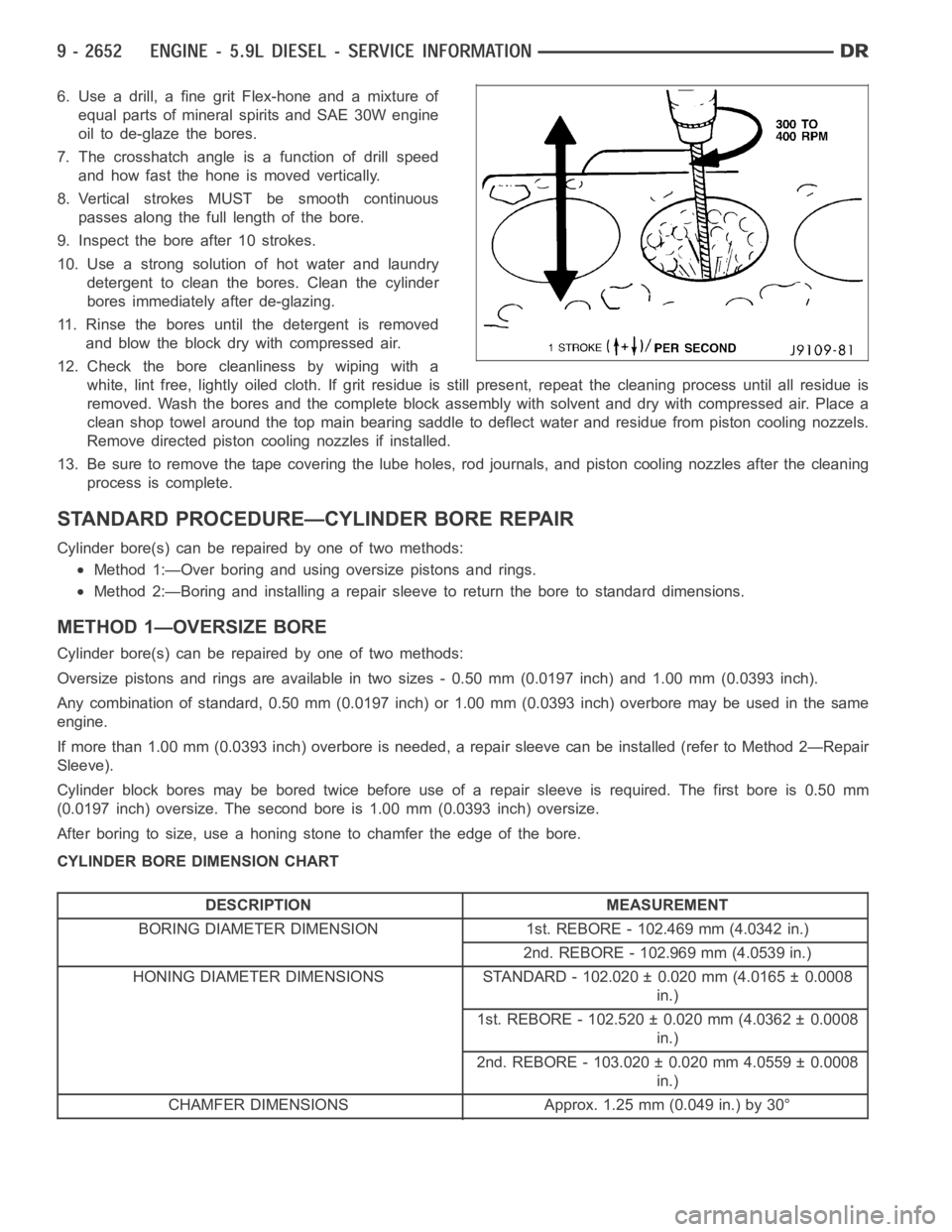
6. Use a drill, a fine grit Flex-hone and a mixture of
equal parts of mineral spirits and SAE 30W engine
oil to de-glaze the bores.
7. The crosshatch angle is a function of drill speed
and how fast the hone is moved vertically.
8. Vertical strokes MUST be smooth continuous
passes along the full length of the bore.
9. Inspect the bore after 10 strokes.
10. Use a strong solution of hot water and laundry
detergent to clean the bores. Clean the cylinder
bores immediately after de-glazing.
11. Rinse the bores until the detergent is removed
and blow the block dry with compressed air.
12. Check the bore cleanliness by wiping with a
white, lint free, lightly oiled cloth. If grit residue is still present, repeat the cleaning process until all residue is
removed. Wash the bores and the complete block assembly with solvent and dry with compressed air. Place a
clean shop towel around the top main bearing saddle to deflect water and residue from piston cooling nozzels.
Remove directed piston cooling nozzles if installed.
13. Be sure to remove the tape covering the lube holes, rod journals, and piston cooling nozzles after the cleaning
process is complete.
STANDARD PROCEDURE—CYLINDER BORE REPAIR
Cylinder bore(s) can be repaired by one of two methods:
Method 1:—Over boring and using oversize pistons and rings.
Method 2:—Boring and installing a repair sleeve to return the bore to standard dimensions.
METHOD 1—OVERSIZE BORE
Cylinder bore(s) can be repaired by one of two methods:
Oversize pistons and rings are available in two sizes - 0.50 mm (0.0197 inch) and 1.00 mm (0.0393 inch).
Any combination of standard, 0.50 mm (0.0197 inch) or 1.00 mm (0.0393 inch)overbore may be used in the same
engine.
If more than 1.00 mm (0.0393 inch) overbore is needed, a repair sleeve can beinstalled (refer to Method 2—Repair
Sleeve).
Cylinder block bores may be bored twice before use of a repair sleeve is required. The first bore is 0.50 mm
(0.0197 inch) oversize. The second bore is 1.00 mm (0.0393 inch) oversize.
After boring to size, use a honing stone to chamfer the edge of the bore.
CYLINDER BORE DIMENSION CHART
DESCRIPTION MEASUREMENT
BORING DIAMETER DIMENSION 1st. REBORE - 102.469 mm (4.0342 in.)
2nd. REBORE - 102.969 mm (4.0539 in.)
HONING DIAMETER DIMENSIONS STANDARD - 102.020 ± 0.020 mm (4.0165 ± 0.0008
in.)
1st. REBORE - 102.520 ± 0.020 mm (4.0362 ± 0.0008
in.)
2nd. REBORE - 103.020 ± 0.020 mm 4.0559 ± 0.0008
in.)
CHAMFER DIMENSIONS Approx. 1.25 mm (0.049 in.) by 30°